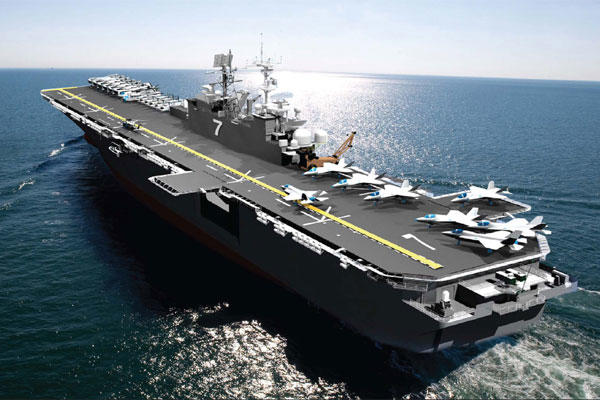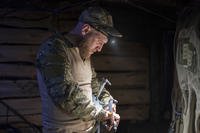Senior Pentagon leaders and weapons developers are looking to more fully integrate operational energy considerations into the acquisition process by working with the services to build energy-efficient aircraft, ships, vehicles, solar panels and new high-efficiency engines, among other things.
As the Pentagon’s formal weapons development process works to establish "energy performance" as a key performance parameter in its Joint Capabilities Integration Development System, or JCIDS, acquisition leaders are engineering operational energy into next generation equipment.
"We’re working with the services and [combatant commands] on exercises and war games. We’re engaging early in the force development process and also in the requirements generation process," said Sharon E. Burke, assistant Secretary of Defense for Operational Energy Plans and Programs.
The idea is to harness near-term technologies for the benefit of ongoing operations while casting a longer-term developmental strategic view firmly grounded in the need to produce, store, maintain and transport energy; the strategy is naturally aimed at lowering long-term energy costs in light of global developments but also immersed in seeking to identify and harness the tactical and operational advantages from energy-efficient technologies.
The Army has deployed solar powered tents and blanket which use a technology referred to as photovoltaics, or PV, a technique which converts sunlight into electrical energy. PV is able to charge phones, laptops and batteries and other items for units who are forward deployed, without requiring a generator.
Tent-like structures equipped with PV technology and solar-powered blankets called Rucksack Enhanced Portable Power Systems, or REPPS, have been forward deployed with Army units.
These technologies provide dismounted units on the move with a tactical advantage, often performing the much-desired task of lowering the amount of weight individual soldiers have to haul on missions, Burke explained.
Also, the Army is making progress developing a next-generation helicopter engine able to provide more horsepower while increasing fuel efficiency. Army’s Improved Turbine Engine Program, or ITEP, is a more powerful, fuel-efficient helicopter engine which evolved from a service Science and Technology program.
The ITEP program is slated to power the Army’s UH-60 Black Hawk utility helicopter and AH-64 Apache attack aircraft as well as possibly power future helicopters now in development.
In addition, the Army continues to work on a range of technologies with operational energy benefits, to include lighter-weight body armor, smaller batteries with what’s called higher energy density, hybrid-electric propulsion systems for vehicles.
AIR FORCE
A key example of the approach to build energy efficiency into the acquisition process is evidenced in the ongoing procurement of the Air Force’s Combat Rescue Helicopter, or CRH, a new helicopter program designed to replaces the service’s currently serving HH-60.
A contract award on the CRH program is expected sometime in the first quarter of FY 14, said Air Force spokesman Ed Gulick.
"It was in the RFP [Request for Proposal] that we were looking for better energy performance and that it would be a criteria in the contract," Burke explained.
Also, the Air Force’s Adaptive Versatile Engine Technology, or ADVENT, is a next-generation engine technology program designed to provide aircraft with both high-speeds and increased fuel efficiency.
"Adaptive engine technologies combine the best characteristics of both fuel efficient and high performance engines to achieve range improvements on the order of 25-30 percent and fuel efficiencies on the order of 25 percent for future combat aircraft," according an Air Force press statement.
Emerging out of the Air Force Research Laboratory, the ADVENT effort is joined by a companion effort to improve engine technology called Adaptive Engine Technology Development, or AETD.
"ADVENT and AETD technology-enabled propulsion has the potential to reduce Air Force fuel consumption through 2040 by 1.4 billion gallons, translating to a savings of $5.2B at the current "pump price" of JP-8 fuel," the statement reads.
NAVY
Burke also mentioned the Navy’s current effort to build hybrid-electric big-deck amphibious assault ships. The USS America (LHA-6) and the USS Tripoli (LHA-7) are both part of what the Navy calls its now-in-development America-class Amphibious Assault Ships engineered with a hybrid-drive propulsion system, meaning the ships can use both diesel electric propulsion as well as gas-turbine engines.
Burke made the point that these hybrid-electric propulsion systems also afford greater occasion to produce on-board power for various computers, electronics and weapons systems such as lasers or an electromagnetic rail gun.
"If an amphib can go further and longer before it needs to refuel either at sea before going into port; that is an important operational gain. Also, we have so much more equipment on every platform that requires power so you can run those systems off of a hybrid electric drive rather than off of an engine," said Burke.
When it comes to ship propulsion, hybrid-electric propulsion involves a gas turbine engine as well as an electric motor and diesel generator. The electric motors can help propel the ship at speeds up to around 12 knots, and the generator can generate electricity for the ship.
When it comes to traveling at speeds greater than roughly 12 knots or so, the ship can then rely upon its gas turbine engine. At the same time, the generators can also provide on-board power for many of the ships systems such as sensors, weapons and other electronics, according to Navy officials.
The Naval Sea Systems Command recently released a "Naval Power Systems Technology Development Roadmap," designed to pave a technological path forward regarding the increased demand for power on ships.
At the same time, reducing fuel costs are also a substantial part of the Navy’s "Great Green Fleet" initiative wherein an entire USS Nimitz Carrier group, including both ships and air assets, were successfully powered by a 50-50 blend of biofuels and traditional fuel during last-year’s Rim of the Pacific, an international maritime exercise.




























